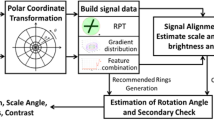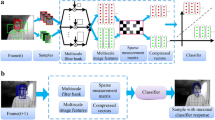Abstract
This article discusses a generalization of the 1-dimensional multi-reference alignment problem. The goal is to recover a hidden signal from many noisy observations, where each noisy observation includes a random translation and random dilation of the hidden signal, as well as high additive noise. We propose a method that recovers the power spectrum of the hidden signal by applying a data-driven, nonlinear unbiasing procedure, and thus the hidden signal is obtained up to an unknown phase. An unbiased estimator of the power spectrum is defined, whose error depends on the sample size and noise levels, and we precisely quantify the convergence rate of the proposed estimator. The unbiasing procedure relies on knowledge of the dilation distribution, and we implement an optimization procedure to learn the dilation variance when this parameter is unknown. Our theoretical work is supported by extensive numerical experiments on a wide range of signals.







Similar content being viewed by others
References
Abbe, E., Bendory, T., Leeb, W., Pereira, J.M., Sharon, N., Singer, A.: Multireference alignment is easier with an aperiodic translation distribution. IEEE Trans. Inf. Theory 65(6), 3565–3584 (2018)
Bandeira, A.S., Boumal, N., Voroninski, V.: On the low-rank approach for semidefinite programs arising in synchronization and community detection. In: Proceedings of the Conference on Learning Theory, pp. 361–382 (2016)
Bandeira, A.S., Charikar, M., Singer, A., Zhu, A.: Multireference alignment using semidefinite programming. In: Proceedings of the 5th Conference on Innovations in Theoretical Computer Science, pp. 459–470 (2014)
Bandeira, A.S., Boumal, N., Singer, A.: Tightness of the maximum likelihood semidefinite relaxation for angular synchronization. Math. Program. 163(1–2), 145–167 (2017)
Bandeira, A.S., Chen, Y., Lederman, R.R., Singer, A.: Non-unique games over compact groups and orientation estimation in cryo-em. Inverse Probl. 36(6), 064002 (2020)
Bandeira, A.S., Niles-Weed, J., Rigollet, P.: Optimal rates of estimation for multi-reference alignment. Math. Stat. Learn. 2(1), 25–75 (2020)
Bendory, T., Edidin, D.: Toward a mathematical theory of the crystallographic phase retrieval problem. SIAM J. Math. Data Sci. 2(3), 809–839 (2020)
Bendory, T., Boumal, N., Ma, C., Zhao, Z., Singer, A.: Bispectrum inversion with application to multireference alignment. IEEE Trans. Signal Process. 66(4), 1037–1050 (2017)
Bendory, T., Beinert, R., Eldar, Y.C.: Fourier phase retrieval: uniqueness and algorithms. In: Boche, H., Calderbank, R., Kutyniok, G., Vybiral, J. (eds.) Compressed Sensing and Its Applications, pp. 55–91. Birkhäuser, Cham (2017)
Boumal, N.: Nonconvex phase synchronization. SIAM J. Optim. 26(4), 2355–2377 (2016)
Bowman, G.D., Poirier, M.G.: Post-translational modifications of histones that influence nucleosome dynamics. Chem. Rev. 115(6), 2274–2295 (2015)
Brown, L.G.: A survey of image registration techniques. ACM Comput. Surv. (CSUR) 24(4), 325–376 (1992)
Capodiferro, L., Cusani, R., Jacovitti, G., Vascotto, M.: A correlation based technique for shift, scale, and rotation independent object identification. In: Proceedings of the IEEE International Conference on Acoustics, Speech, and Signal Processing (ICASSP), vol. 12, pp. 221–224 (1987)
Carroll, R.J., Hall, P.: Low order approximations in deconvolution and regression with errors in variables. J. R. Stat. Soc. Ser. B (Stat. Methodol.) 66(1), 31–46 (2004)
Chandran, V., Elgar, S.L.: Position, rotation, and scale invariant recognition of images using higher-order spectra. In: Proceedings of the IEEE International Conference on Acoustics, Speech, and Signal Processing (ICASSP), vol. 5, pp. 213–216 (1992)
Chen, Y., Guibas, L.J., Huang, Q.X.: Near-optimal joint object matching via convex relaxation. In: Proceedings of the 31st International Conference on Machine Learning. Proceedings of Machine Learning Research, vol. 32, pp. 100–108 (2014)
Chen, Y., Candès, E.J.: The projected power method: an efficient algorithm for joint alignment from pairwise differences. Commun. Pure Appl. Math. 71(8), 1648–1714 (2018)
Chen, H., Zehni, M., Zhao, Z.: A spectral method for stable bispectrum inversion with application to multireference alignment. IEEE Signal Process. Lett. 25(7), 911–915 (2018)
Cheney, E.W., Kincaid, D.R.: Numerical Mathematics and Computing. Brooks/Cole Cengage Learning, Boston (2012)
Cheng, C., Jiang, J., Sun, Q.: Phaseless sampling and reconstruction of real-valued signals in shift-invariant spaces. J. Fourier Anal. Appl. 25, 1361–1394 (2019)
Collis, W., White, P., Hammond, J.: Higher-order spectra: the bispectrum and trispectrum. Mech. Syst. Signal Process. 12(3), 375–394 (1998)
Delaigle, A.: An alternative view of the deconvolution problem. Stat. Sin. 18(3), 1025–1045 (2008)
Dempster, A.P., Laird, N.M., Rubin, D.B.: Maximum likelihood from incomplete data via the EM algorithm. J. R. Stat. Soc.: Ser. B (Methodol.) 39(1), 1–22 (1977)
DesJarlais, R., Tummino, P.J.: Role of histone-modifying enzymes and their complexes in regulation of chromatin biology. Biochemistry 55(11), 1584–1599 (2016)
Diamond, R.: On the multiple simultaneous superposition of molecular structures by rigid body transformations. Protein Sci. 1(10), 1279–1287 (1992)
Ekman, D., Björklund, Å.K., Frey-Skött, J., Elofsson, A.: Multi-domain proteins in the three kingdoms of life: orphan domains and other unassigned regions. J. Mol. Biol. 348(1), 231–243 (2005)
Forneris, F., Wu, J., Gros, P.: The modular serine proteases of the complement cascade. Curr. Opin. Struct. Biol. 22(3), 333–341 (2012)
Foroosh, H., Zerubia, J.B., Berthod, M.: Extension of phase correlation to subpixel registration. IEEE Trans. Image Process. 11(3), 188–200 (2002)
Giannakis, G.B.: Signal reconstruction from multiple correlations: frequency-and time-domain approaches. J. Opt. Soc. Am. A 6(5), 682–697 (1989)
Gil-Pita, R., Rosa-Zurera, M., Jarabo-Amores, P., López-Ferreras, F.: Using multilayer perceptrons to align high range resolution radar signals. In: Proceedings of 15th International Conference on Artificial Neural Networks: Formal Models and Their Applications, pp. 911–916 (2005)
Hansen, L.P.: Large sample properties of generalized method of moments estimators. Econometrica 50(4), 1029–1054 (1982)
Hirn, M., Little, A.: Wavelet invariants for statistically robust multi-reference alignment. Inf. Inference J. IMA 10(4), 1287–1351 (2021)
Hotta, K., Mishima, T., Kurita, T.: Scale invariant face detection and classification method using shift invariant features extracted from log-polar image. IEICE Trans. Inf. Syst. 84(7), 867–878 (2001)
Kam, Z.: The reconstruction of structure from electron micrographs of randomly oriented particles. J. Theor. Biol. 82(1), 15–39 (1980)
Leggett, R.M., Heavens, D., Caccamo, M., Clark, M.D., Davey, R.P.: Nanook: multi-reference alignment analysis of nanopore sequencing data, quality and error profiles. Bioinformatics 32(1), 142–144 (2015)
Levitt, M.: Nature of the protein universe. Proc. Natl. Acad. Sci. 106(27), 11079–11084 (2009)
Lim, W.A.: The modular logic of signaling proteins: building allosteric switches from simple binding domains. Curr. Opin. Struct. Biol. 12(1), 61–68 (2002)
Mallat, S.: A Wavelet Tour of Signal Processing: The Sparse Way, 3rd edn. Academic Press, Boston (2008)
Martinec, D., Pajdla, T.: Robust rotation and translation estimation in multiview reconstruction. In: Proceedings of the IEEE Conference on Computer Vision and Pattern Recognition, pp. 1–8 (2007)
McGinty, R.K., Tan, S.: Recognition of the nucleosome by chromatin factors and enzymes. Curr. Opin. Struct. Biol. 37, 54–61 (2016)
Meynard, A., Torrésani, B.: Spectral analysis for nonstationary audio. IEEE/ACM Trans. Audio Speech Lang. Process. 26(12), 2371–2380 (2018)
Omer, H., Torrésani, B.: Estimation of frequency modulations on wideband signals; applications to audio signal analysis. http://arxiv.org/abs/1305.3095 (2013)
Omer, H., Torrésani, B.: Time-frequency and time-scale analysis of deformed stationary processes, with application to non-stationary sound modeling. Appl. Comput. Harmon. Anal. 43(1), 1–22 (2017)
Park, W., Chirikjian, G.S.: An assembly automation approach to alignment of noncircular projections in electron microscopy. IEEE Trans. Autom. Sci. Eng. 11(3), 668–679 (2014)
Park, W., Midgett, C.R., Madden, D.R., Chirikjian, G.S.: A stochastic kinematic model of class averaging in single-particle electron microscopy. Int. J. Robot. Res. 30(6), 730–754 (2011)
Perry, A., Wein, A.S., Bandeira, A.S., Moitra, A.: Message-passing algorithms for synchronization problems over compact groups. Commun. Pure Appl. Math. 71(11), 2275–2322 (2018)
Robinson, D., Farsiu, S., Milanfar, P.: Optimal registration of aliased images using variable projection with applications to super-resolution. Comput. J. 52(1), 31–42 (2007)
Sadler, B.M., Giannakis, G.B.: Shift- and rotation-invariant object reconstruction using the bispectrum. J. Opt. Soc. Am. A 9(1), 57–69 (1992)
Scheres, S.H., Valle, M., Nuñez, R., Sorzano, C.O., Marabini, R., Herman, G.T., Carazo, J.M.: Maximum-likelihood multi-reference refinement for electron microscopy images. J. Mol. Biol. 348(1), 139–149 (2005)
Sharon, N., Kileel, J., Khoo, Y., Landa, B., Singer, A.: Method of moments for 3-D single particle ab initio modeling with non-uniform distribution of viewing angles. Inverse Probl. 36(4), 044003 (2020)
Shechtman, Y., Eldar, Y.C., Cohen, O., Chapman, H.N., Miao, J., Segev, M.: Phase retrieval with application to optical imaging: a contemporary overview. IEEE Signal Process. Mag. 32(3), 87–109 (2015)
Singer, A.: Angular synchronization by eigenvectors and semidefinite programming. Appl. Comput. Harmon. Anal. 30(1), 20–36 (2011)
Sun, W.: Phaseless sampling and linear reconstruction of functions in spline spaces. http://arxiv.org/abs/1709.04779 (2017)
Theobald, D.L., Steindel, P.A.: Optimal simultaneous superpositioning of multiple structures with missing data. Bioinformatics 28(15), 1972–1979 (2012)
Tsatsanis, M.K., Giannakis, G.B.: Translation, rotation, and scaling invariant object and texture classification using polyspectra. In: SPIE Advanced Signal Processing Algorithms, Architectures, and Implementations, vol. 1348, pp. 103–115 (1990)
Yellott, J.I., Iverson, G.J.: Uniqueness properties of higher-order autocorrelation functions. J. Opt. Soc. Am. A 9(3), 388–404 (1992)
Zhong, Y., Boumal, N.: Near-optimal bounds for phase synchronization. SIAM J. Optim. 28(2), 989–1016 (2018)
Zwart, J.P., van der Heiden, R., Gelsema, S., Groen, F.: Fast translation invariant classification of HRR range profiles in a zero phase representation. IEE Proc. 150(6), 411–418 (2003)
Acknowledgements
AL thanks NSF DMS 2309570 and NSF DMS 2136198.
Author information
Authors and Affiliations
Corresponding author
Additional information
Communicated by Afonso Bandeira.
Publisher's Note
Springer Nature remains neutral with regard to jurisdictional claims in published maps and institutional affiliations.
Appendices
Appendix A Proof of Lemma 1
Proof
for constants \({B_0}, {B_1}, {B_2}\) defined in (5). Letting \(\Vert \cdot \Vert \) denote the spectral norm, we thus obtain:
We first observe that \(\Vert L_C^i \Vert =C^\frac{5i}{2}\) since
Thus
so that
and we obtain
\(\square \)
Appendix B Proof of Lemma 2
Proof
Note by assumption there exist constants \(C>0\), \(\omega _0\ge 1\) such that \(|\widehat{h} (\omega )|\le C|\omega |^{-\alpha }\) for \(|\omega |\ge \omega _0\). Also note that \(\widehat{\phi }_L(\omega )=e^{-L^2\omega ^2/2}\), so that \(1-\widehat{\phi }_L(\omega ) = \frac{L^2\omega ^2}{2}+O(L^3)\) for small L. We have:
Note:
To control the second term, note
Explicit evaluation of the upper bound with a computer algebra system gives:
Also since
the upper bound is decreasing in \(\alpha \), and we can conclude \((II) \lesssim L^{4\wedge (2\alpha -1)}\) and the lemma is proved. \(\square \)
Appendix C Proof of Lemma 3
Proof
First observe:
To bound the first term, we apply Lemma 2 to the function xh to obtain,
To bound the second term, note \(\widehat{\phi }_L'(\omega ) = -L^2\omega e^{-L^2\omega ^2/2}\), and that \(\Vert \omega ^2 e^{-L^2\omega ^2}\Vert _{\infty } = (eL)^{-1}\). Thus
Note we could get a higher power for L by
which proves the lemma. \(\square \)
Rights and permissions
Springer Nature or its licensor (e.g. a society or other partner) holds exclusive rights to this article under a publishing agreement with the author(s) or other rightsholder(s); author self-archiving of the accepted manuscript version of this article is solely governed by the terms of such publishing agreement and applicable law.
About this article
Cite this article
Hirn, M., Little, A. Power Spectrum Unbiasing for Dilation-Invariant Multi-reference Alignment. J Fourier Anal Appl 29, 43 (2023). https://doi.org/10.1007/s00041-023-10023-5
Received:
Revised:
Accepted:
Published:
DOI: https://doi.org/10.1007/s00041-023-10023-5




